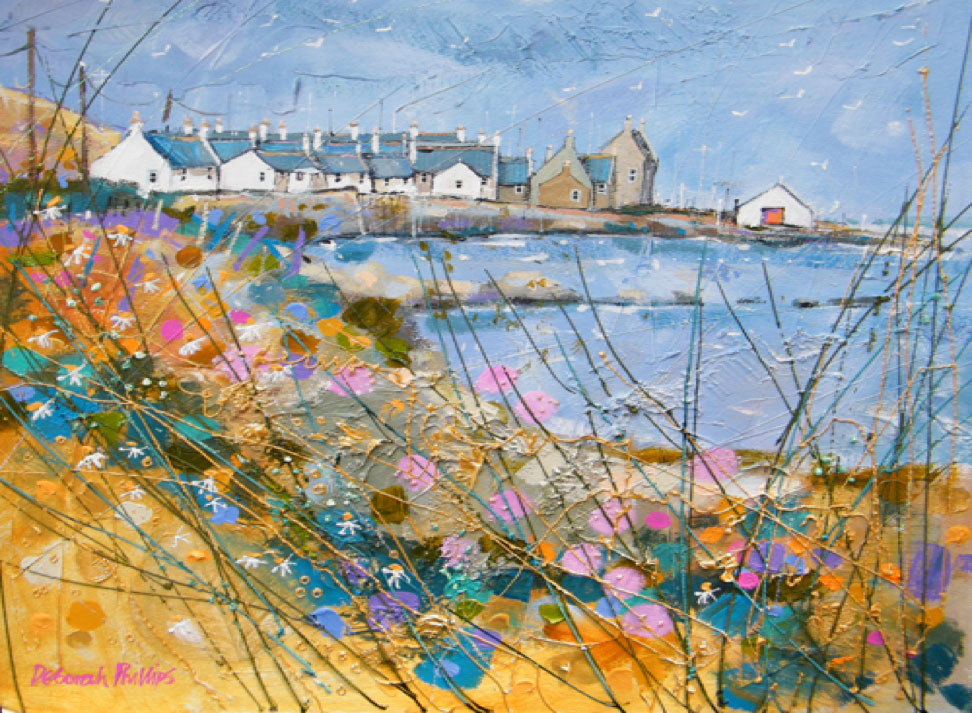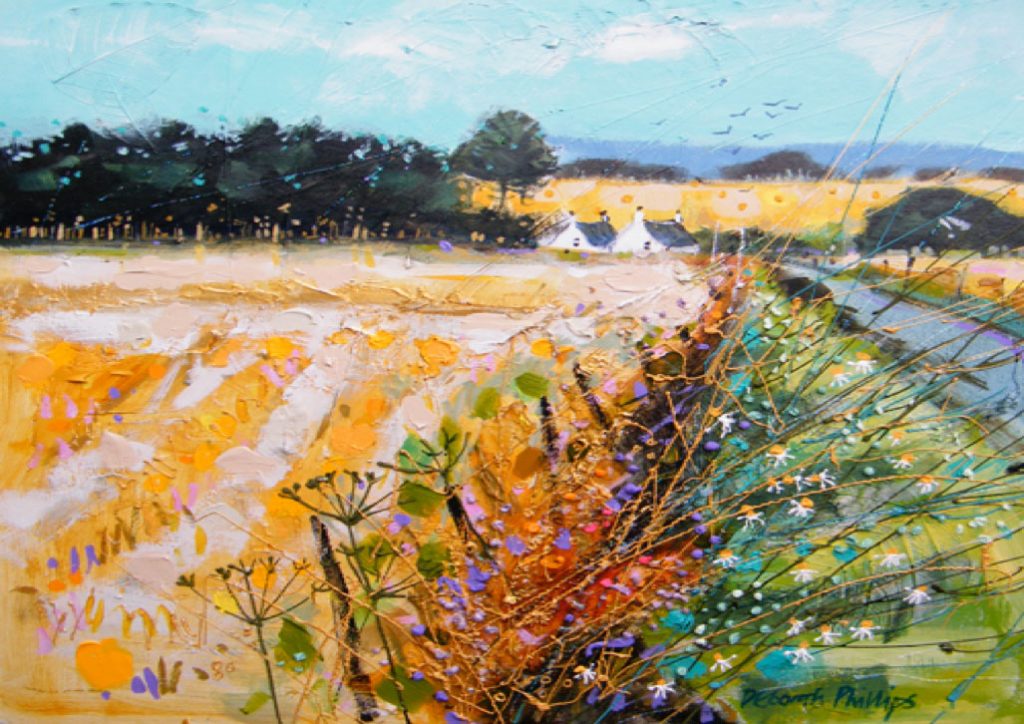Deborah Phillips Glass Artist
Deborah Phillips from Dundee, Scotland; work just makes me want to smile. She brings the Scottish countryside alive with acrylic paint. You feel as though you are there with Deborah, peeping through the meadow grasses and flowers to the landscapes beyond.
“I enjoy all aspects of creating a painting, from going out into the stunning Scottish countryside to collect reference material, priming the board on which I will paint, squeezing paint from the tubes and watching it glisten on palette holding the well-used brushes, mixing the squelchy colour and applying it in swathes, varnishing, framing and then seeing the finished article on a gallery wall every stage gives me a thrill.” Deborah Phillips
Zoneone Arts is delighted to bring Deborah Phillips to you…

‘White Gables near Nigg’
You first exhibited at the very young age of fourteen. Can you explain how this came about and how did it affect your choices to become an artist?
I was born into a very creative family my father being a painter and my mother very musically minded. I was encouraged to draw and paint from the moment I could hold a pencil and brush so it was inevitable that I would take up a career in art in some shape or form. My father submitted my work, without my knowledge, to the Royal Scottish Academy and the Royal Glasgow Institute annual exhibitions when I was 14 so when my work was accepted and hung it was quite a thrill.

Wheeling Gulls over Sandend
Your father was a well know artist, did you work and exhibit together?
Sadly my father passed away last year. He was a great talent, a wonderfully accomplished and versatile artist. We would often gather subjects and reference material together however; we had our own separate studios to work in. We did regularly exhibit together in mixed shows and on several occasions we had joint 2 person shows. Although no longer with us, I have another 3 joint exhibitions with him in the pipeline.
How has he influenced you and your artwork?
My father was the most wonderful mentor and encouraged me from the word go. I can’t remember a time that he didn’t encourage me to draw and paint. He was always ready to give constructive criticism but was generous with his praise and encouragement too.

The Road to Dornoch
When I look at your work I feel as though I am crouched down beside you. Is this how you want the viewer to feel?
Yes! My husband and I very much enjoy the Scottish countryside and we take long drives to explore new places. All the time, I am on the look-out for new subjects and ideas so he is regularly told to ‘Stop!’ while I jump out of the car and into a hedgerow at the side of the road to make a sketch or take a quick photograph. Inevitably the foreground weeds and wildflowers make it into my paintings.

Wet Furrows at Drumeldrie
Do you paint the same places at different times of the year or day?
I try not to revisit the same subjects too often however, there are some compositions that are just too good not to revisit and reinvent. However, when I do repaint a subject, there is always something new to add whether it is a change in light or colour palette. No two paintings ever are the same.

Morning Sunlight Pittenweem
Discuss the importance of the seasons to your work?
Just now I am painting the crisp late winter sun with the contrast of strong light and dark shadows on the white and coloured buildings of the East Neuk of Fife (an area of Scotland filled with picturesque fishing villages) As the year progresses I shall move onto spring greens and come summer the palette will change to harvest yellows and golds.
Colour is very important to your work. Can you expand on your use of colour?
I love using complimentary vibrant colours to add a real fizzy zing to my work. However, I equally enjoy putting together gentle, sympathetic colours too to convey distance in a rolling landscape. I initially trained in Printed Textiles at Duncan of Jordanstone College of Art in Dundee which I think has given me a good eye and appreciation of the juxtaposition of colours, shape and texture.

Harvest Poppy Patch
‘Golden Autumn Duirinish’ makes me smile. You bring so much into this painting. The knowledge of being part of the meadow while being aware of the domestic scene beyond. Can you discuss your techniques in this and other similar paintings?
Although I very rarely include figures in my work, I like to convey a sense of life and movement in my work, hence the windblown weeds, fluttering laundry on the line, buffeted birds and gulls in a blustery sky and puffs of smoke on the breeze from cottage chimneys. All these elements come together to

Golden Autumn Duirinish
How do you do your paintings? Are they done in your studio or plain air?
I always paint in the studio. I have everything I need set up around me, my paints, my music all conveniently placed around me and of course my easel which is situated right beside the window where I can look out over the rooftops of central Dundee to the River Tay and Fife. Bliss!
Please discuss the size of your paintings?
My paintings range from tiny tiddlers of just a few inches across to much, much larger pieces, however, on the whole, the bulk of my work is normally around 18” x 18” and 22” x 22”. I know it sounds crazy, but I like to paint sizes that will fit in the boot of my car! From a purely practical point of view, it makes delivering to galleries so much easier.
The area in the foreground is very important for your work. Can you tell us about both the content and the technique you use?
Yes, I love doing the foregrounds and spend a lot of time layering, dragging and splattering paint. It’s a technique that I’ve developed over a period of years and which I will no doubt continue to evolve further.
Pink Highland Harvest
Your images are timeless. Is this your intention?
“Timeless”, thank you, that is quite a compliment indeed. My intention is to produce images which can happily be lived with for years, paintings that can evoke a feeling and can lift spirits, change a mood – an image that draws the viewer in. I suppose then, they are timeless.

Low Horizon
When your work is not full of colour you restrict you palette to one or two colours using tones. Can you explain this?
These paintings which use quite a restricted palette tend to those which I want to evoke a feeling of distance, rolling countryside at dawn or dusk.
Your work leaves me wanting to add the sense of smell. I can almost smell the grass and flowers, the freshly turned earth, the making of hay. Have others commented on this?
Actually yes, I have had a number of people telling me that they can imagine breathing in cool Highland air, can smell the saltiness of the sea, sniffing the field-edge daisies and even the peaty smoke from a cottage chimney. I’m delighted that my work can covey so much more than merely an image.

Cool Night Air
Can you describe your studio and the way you allocate out your time to your painting?
There is one word for my studio – chaotic! Every so often I have a massive tidy-up and then I can’t find anything for weeks, therefore, I do prefer to keep my organised chaos. I tend to deal with all my administrative stuff in the mornings updating the website, gallery correspondence, visiting the framer, wrapping paintings for delivery, etc.
Dealing with all these necessary chores leaves the afternoon through to the early evening clear to get down to the important stuff – painting.
Contact:
Deborah Phillips
www.deborahphillips.com
info@deborahphillips.com
Facebook: www.facebook.com/pages/Deborah-Phillips-Artist
Twitter: @PhillipsFineArt
Interview by Deborah Blakeley, March 2013
Think a colleague or friend could benefit from this interview?
Knowledge is one of the biggest assets in any business. So why not forward this on to your friends and colleagues so they too can start taking advantage of the insightful information the artist has given?
Other artists you may be interested in:






